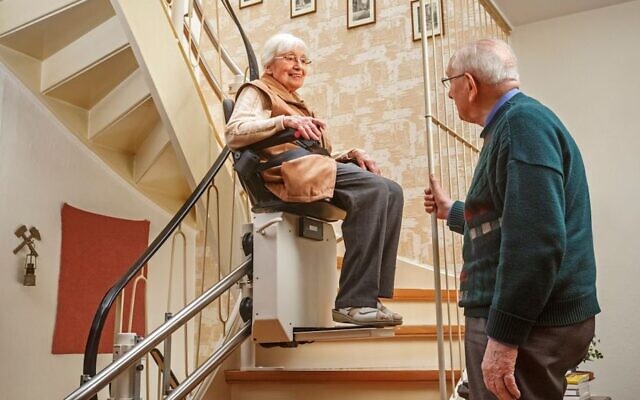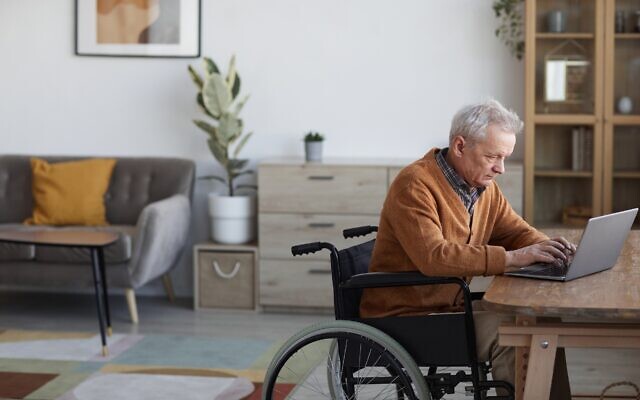Renovate or Relocate? How to Successfully Age in Place
Experts agree that planning ahead makes all the difference; their suggestions tell you what to expect and what steps to take.
Chana Shapiro is an educator, writer, editor and illustrator whose work has appeared in journals, newspapers and magazines. She is a regular contributor to the AJT.

More seniors are opting to age in place than ever before. According to a Seniorlink blog by Angela Stringfellow, the trend has been “driven by the rising costs of long-term care, coupled with the rapidly growing senior population of aging Baby Boomers, who enjoy a more active, vibrant lifestyle than previous generations.”
In fact, the Urban Institute claims that the number of households headed by people 65 and older is expected to grow from 34 million to 48 million in the next 20 years. Technology and wider availability of services, such as home meal delivery, are making it easier for older adults to remain in place.

The World Health Organization, concerned with healthy aging of the growing population, explains that healthy aging is “the process of developing and maintaining the functional ability that enables wellbeing in older age,” and, according to many senior adult organizations, an increasing number of older adults believe that the best place for their wellbeing is in their own home.
According to AARP’s 2021 Home and Community Preferences Survey, three out of four adults who are 50 or older say that they want to stay in their homes and communities as they age, and most are now financially equipped to do so. The survey found that nearly 80 percent of respondents over the age of 50 own their homes and 51 percent have no mortgage.
But owning a home does not guarantee being able to remain in it through old age. A study by Family Caregiving reports that, “While some adults have a home with features to allow them to remain in place as they get older, like a bathroom on the main level (80 percent) or a room on the first floor that could be used as a bedroom (82 percent), many respondents said they would need to make changes to stay at home comfortably and safely.” The survey also notes that most at-home seniors prefer retrofitting their own residences rather than moving to a senior residential facility or into their children’s homes. This requires careful planning, and perhaps even new construction, to update existing rooms, and install devices that do not exist in their present structure.
A recent Urban Institute survey reported that the most crucial adjustments are entry threshold ramps and bathroom safety changes. A third of those polled said they would be willing to make the necessary changes. Joanne Bradley, Georgia supervisor of Amramp, a leading provider of accessibility solutions, helps homeowners retrofit their homes. She advises installing a ramp that is ADA (American Disabilities Act) compliant, widening the door width of the master bedroom; modifying the shower entrance (“even a 3” rise is too challenging”); and installing grab bars around the toilet and in the shower.

Bradley adds, “If I have to pick one thing to correct, it would be an ADA-compliant entrance into the home, but if a ramp is too steep, there is serious potential risk. All the other issues of aging in place can be achieved with great products that can help with almost any issue. Everything is expensive today. When it comes to aging in place, take care of major up-front costs, like ramps, first. Everything after that should be easier.” The National Institute on Aging (NIA) website suggests the following:
- Remove area rugs and affix all carpets firmly to the floor.
- Replace handles on doors or faucets with ones that are comfortable for you to use.
- Install grab bars near toilets and in the tub or shower.
- Place no-slip strips or non-skid mats on tile, wood floors and all surfaces that get wet.
- Place light switches at the top and bottom of stairs and turn on night lights.Stringfellow, the blogger, recommends going through one’s house, room-by-room, looking for problem areas like potential tripping or slipping hazards, areas that are hard to access and difficult to maintain, and unnecessary furniture or rugs.
She emphasizes the following:
- Cover your home entry. Upgrade lighting indoors and out. Install intercom to doors. Add wheelchair-height peepholes. Trim foliage around house and away from walkways. Repair uneven walkways.
- Move the master bedroom downstairs or install a stairlift. Widen doors for wheelchairs and walkers.
- Have a phone in every room, including bathrooms.
- Replace bathtub with a walk-in shower or tub, with grab bars. Get a shower chair and a raised toilet seat. Install roll-in showers with adjustable shower heads and a handheld one with a long hose. Replace curtain tension rod with permanent rod. Place rubber mats inside and outside shower. Optimally, lower portion of the bathroom sink with proper knee clearance. Label or color-code hot and cold faucets. Set water at 120 degrees or lower.
- Retrofit kitchen cabinets with drawers and pull-out shelves. Get an electric cook top with level burners, front controls.
The AARP recommends moving laundry near the bedroom or bathroom, lowering light switches, thermostats, faucets, and raising outlets to be reached from sitting or standing and installing a medical alert system and health tracking tools.
Obviously, changes can be cost-prohibitive. The National Aging in Place Council (NAIPC) offers this financial advice: “You can include the medical expense amounts you pay for special equipment installed in a home, or for improvements, if their main purpose is medical care for you, your spouse, or your dependent. The cost of permanent improvements that increase the value of your property may be partly included as a medical expense. If the value of your property is not increased by the improvement, the entire cost is included as a medical expense.”
Some seniors would leave their home for one that allows them to age independently if it wasn’t expensive or was easier to maintain. In a recent study by the Housing Finance Policy Center at the Urban Institute, 60 percent of adults polled said they would consider living in an ADU, a small Accessory Dwelling Unit, located on the property of an existing home or on a small piece of land.
What’s more, 62 percent said they would consider building an ADU on their own property for a loved one who needed care, or a family member or friend who needed a home. Building an ADU can be more affordable and can provide “more of the design features that people of all ages need than some of the older housing.” Those 50-plus said that they would move to be near someone special, if they were able to maintain their own space (69 percent), to have needed support doing daily activities (68 percent), or to save money (48 percent). Other respondents would share a home with a family member (69 percent) or a friend (54 percent). Only 6 percent said that they would share a home with a stranger.
Bradley, of Amramp, stresses, “Middle-aged people should plan ahead if they believe they’ve found their forever home. No one can predict the future, and some changes are quite costly, perhaps even impossible to achieve. If you make changes little by little, the burden will be so much less than if you do it all at once. For example, bathrooms can be remodeled slowly over time. Medical concerns are very expensive, and the unexpected can and will happen. If you are suddenly faced with high hospital and doctor bills, the last thing you want is a big expense to make your home handicapped accessible.”
The AARP gives this advice for seniors considering their housing options: “Start with a safety home assessment by an occupational therapist, physical therapist, geriatric care manager, aging-in-place specialist or qualified professional via the area agency on aging or Department of Veterans Affairs.”
Stringfellow agrees, noting that the 240-point Comprehensive Home Safety Assessment is performed by a trained advisor and includes the exterior of the home, all entry areas, every room — including bathrooms, bedrooms, laundry room, garage, basement, kitchen and dining room, lighting evaluation, fire safety and electrical safety. She cautions that you should “confer with a certified aging in-place-specialist, through the National Association of Homebuilders, and use Universal Design standards for guidance.”
Universal design refers to building environments that are accessible regardless of one’s physical limitations or disabilities. Much of the universal design concept has been codified in the Americans with Disabilities Act of 1990. A complete summary assessment is prepared with recommendations for fall prevention and home safety. If necessary, modifications are suggested, an ADA advisor can refer vetted providers in one’s area.
AARP confirms that most people prefer retrofitting an existing space — even with numerous limitations — rather than constructing a new space. The key is learning what to do and planning ahead.
AARP Findings:
- 79 percent said they would need to modify bathrooms with grab bars or install no-step showers.
- 71 percent said their home has some type of inside and outside accessibility issues
- 61 percent said they would need an emergency response system
- 48 percent said they would need smart-home devices, like a voice activated home assistant or a doorbell camera.
The AARP research was based on 25-minute surveys with 2,826 Americans ages 18 and over. It was weighted to reflect a diverse sample.
- Chana Shapiro
- Senior Living
- Community
- AARP
- Center for Disease Control and Prevention
- ACUs
- accessory dwelling units
- age in place
- handicap-accessible
- home retrofitting
- Comprehensive Home Safety Assessment
- Americans with Disabilities Act
- Department of Veteran Affairs
- Seniorlink
- World Health Organization
- Housing Finance Policy Center at the Urban Institute
- Family Caregiving
- National Aging in Place Council
- Joanne Bradley
- Amramp
- Seniors
- Angela Stringfellow
- Home and Community Preferences Survey
- senior residential facility
- children’s homes
- National Institute on Aging
- Accessory Dwelling Unit
- National Association of Homebuilders
- Universal Design standards



comments